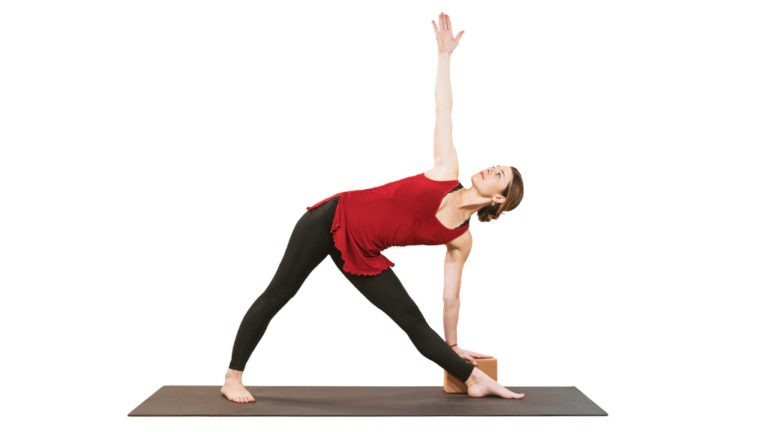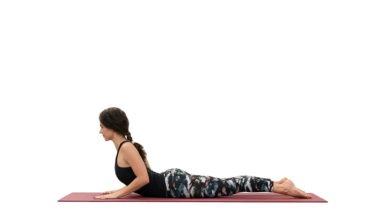Defining Yoga Asanas

The Sanskrit word asana translates into seat in English, but if you say the word to yoga practitioners, all the postures and stretches they know will flash through their minds. Patanjali’s Yoga Sutras simply define asana as a “steady, comfortable posture,” which could be any shape.
In modern yoga context, an asana refers to a physical pose i.e. balasana (child’s pose) or trikonasana (triangle pose).

Trikonasana (triangle pose)
Benefits
Different asanas have different rewards — exploring all the benefits associated with dozens of poses would be more than enough for a book, and beyond the scope of a single article. Asanas also have benefits on physical, spiritual, and energetic levels.
Many begin a yoga practice for stress relief and improved health, but discover benefits such as an increased sense of well-being, easier access to meditative states, and improved emotional stability. The key to experiencing these benefits is persistence over time along with patience, although many feel better after their first yoga class or session.
Watch this free video: The Grace of Pranayama in Asana!
Types of Yoga
- Hatha Yoga: This “radical” style of yoga is based on the premise that the body is the key to enlightenment; by practicing physical austerities and cleansing rituals, practitioners could achieve realization. Hatha yoga emphasizes breathing techniques, and some hatha asanas are rigorous and can take years to master. All physical yogas are considered hatha yoga.
- Iyengar Yoga: This method focuses on fine details of alignment and anatomy. The founder, B.K.S. Iyengar, from Western India, began teaching yoga in 1937. Eventually, he taught to celebrities and luminaries in the west, including the author Aldous Huxley. The Iyengar method migrated to the U.S. beginning in 1957, and by 2005, was considered the most influential yoga model in the world. The Iyengar style is noted for developing mobility and strength with generous use of props.
- Ashtanga Yoga: Ashtanga is an intensive, challenging series of asanas in three series developed by K. Pattabhi Jois.
- Vinyasa Yoga: This method originated from the Ashtanga school in the 1980s, and can be recognized by a breath-to-movement style including sun salutations and usually standing, balancing, and floor series.
- Restorative Yoga: This is a gentle technique designed to relax and de-stress. Bolsters, pillows, and blocks are used to allow practitioners to remain in postures for longer periods than other styles. Restorative yoga may include meditation and breathing (pranayama) components as well.
- Yin Yoga: In the 1970s, martial artist Paulie Zink developed yin yoga with the intention of providing a slow-paced style with longer pose holds — up to five minutes or more. These long holds affect the joints and fascia (connective tissue) in the body, and are believed to increase circulation and flexibility.
Yoga Poses to Ease Digestive Discomfort

If you’re one of the many American who suffers from occasional digestive discomfort, yoga offers a natural way to get relief. Just as you would adapt your diet to address your needs, try including some of these poses into your regular practice.
Cat-Cow – Marjaryasana-Bitilasana

- Improves posture and balance
- Strengthens and stretches the spine and neck
- Stretches the hips, abdomen and bac
- Increases coordination
- Massages and stimulates organs in the belly, like the kidneys and adrenal glands.
- Relieves stress and calms the mind
Downward-Facing Dog – Adho Mukha Svanasana

- Calms the brain and helps relieve stress
- Stretches the shoulders, hamstrings, calves, arches, and hands
- Strengthens the arms and legs
- Relieves headache, insomnia, back pain, and fatigue
- Therapeutic for high blood pressure
- Helps prevent osteoporosis
Extended Puppy Pose – Uttana Shishosana

- Releases tension in you upper arms, shoulders, and neck
- Expands the whole front of your chest
- Stretches out your abdominal muscles
- Gently stimulates your back muscles in preparation for further backbends
- Opens up your hips and stretches your hamstrings
Bridge Pose – Setu Bandha Saravangasana

- Streches your chest, neck, spine, and hips
- Strengthens your back, buttocks, and hamstring muscles
- Calms your brain and central nervous system
- Alleviates stress and mild depression
- Massages abdominal organs and improves digestion/li>
- Relieves the symptoms of menopause
- Reduces anxiety, backaches, headaches, and insomnia
Wind-Relieving Pose – Ardha Pawanmuktasana

- Stretches the neck and back
- Pressure on the abdomen releases any trapped gases in the large intestine
- Blood circulation is increased to all the internal organs
- Relieves constipation
- Strengthens the back and abdominal muscles
- Massages the intestines and other organs in the abdomen
- Eases tension in the lower back




































